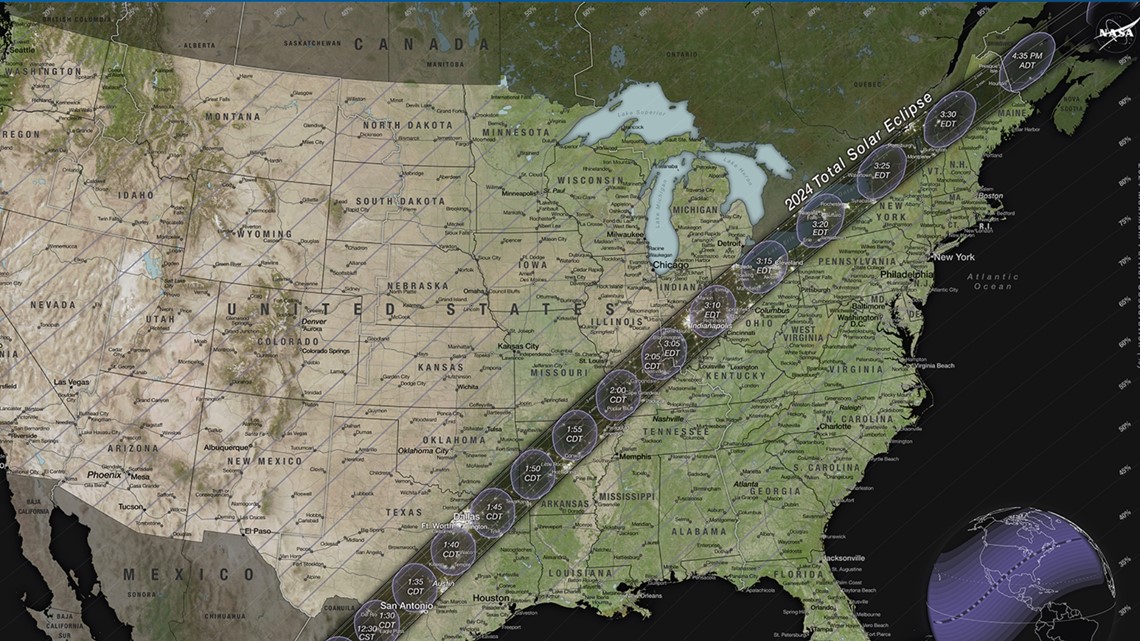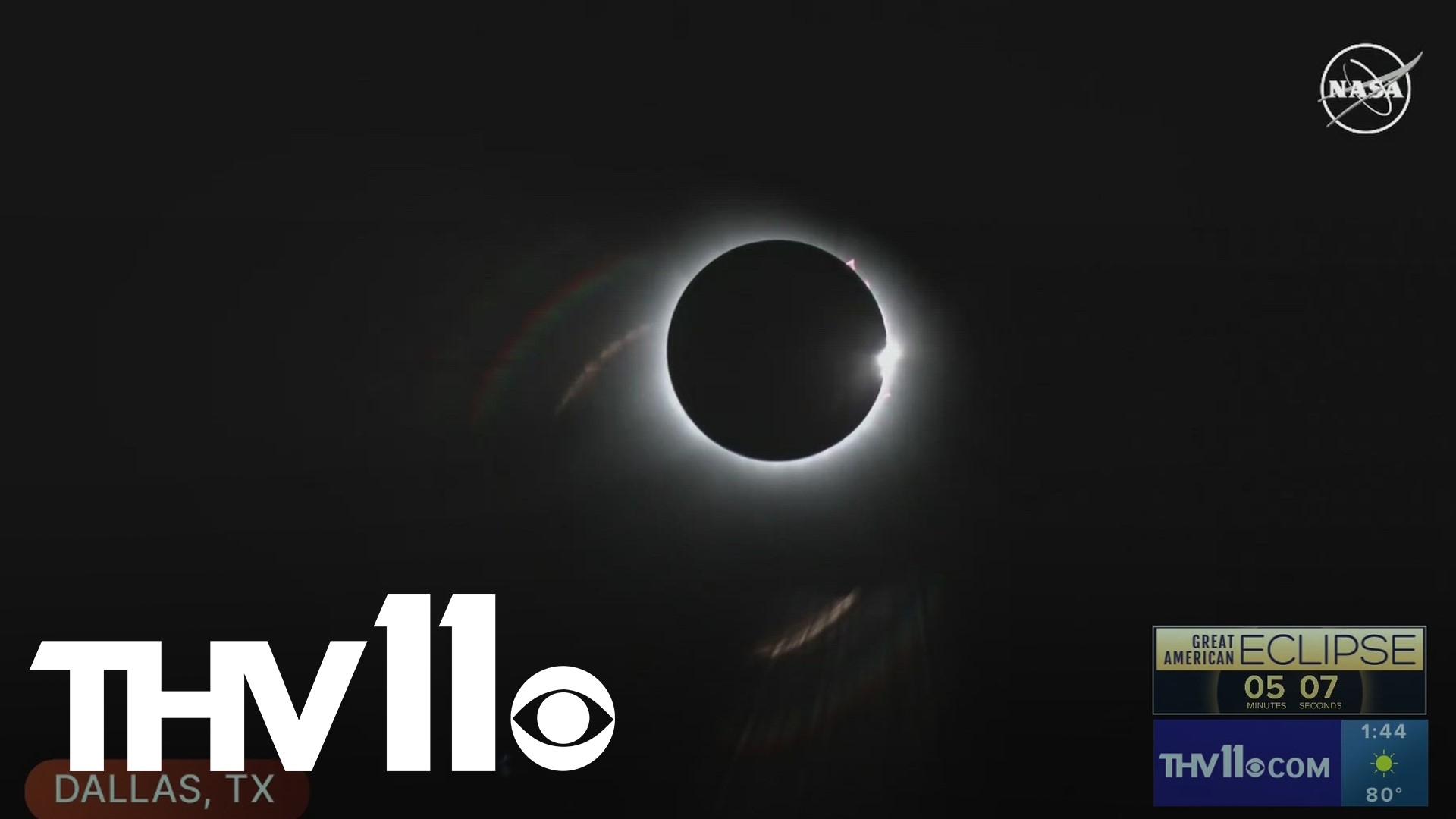WASHINGTON — The time has come for a total solar eclipse.
Millions of Americans along the path of totality will watch as the moon moves in front of the sun, blocking all daylight for as much as four minutes in some areas. From Texas to Maine, eagle-eyed spectators and cosmic enthusiasts will await the rare spectacle slated to being around 1 p.m. Eastern.
It has been nearly seven years since a solar eclipse captured audiences across the U.S.
But don't expect to see an exact repeat of 2017 as Monday's eclipse is visible in more places and will be twice as long.
Those in the path of totality, a 115-mile-wide stretch where the moon will fully cover the sun, are set to experience as much as four minutes of total darkness. Even though the eclipse path doesn't cover the entire U.S., all 50 states will still experience a partial solar eclipse on Monday.
You won't want to miss the total solar eclipse as there won't be another coast-to-coast event like this until 2045.
What time will the solar eclipse start?
Entering the U.S. through Texas, the solar eclipse will begin its partial eclipse phase at around 12:20 pm in CDT in Dallas on Monday, April 8, according to NASA.
Totality is set to begin around 1:40 p.m. CDT until 1:44 p.m. CDT in Dallas, before completely ending at 3 p.m. CDT.
The eclipse will approach the east coast at around 1:59 p.m. EDT, in Cleveland, Ohio. Totality will begin at 3:13 p.m. and end at 3:17 p.m. EDT.
In Maine, the eclipse will begin at 2:22 p.m. EDT, with totality beginning at 3:32 p.m. EDT and ending at 3:34 p.m. EDT.
The eclipse will exit through Newfoundland, Canada at 5:16 p.m. NDT.
How long will the solar eclipse last?
When the eclipse begins and how long it'll last depends on where you are in reference to the path of totality. For some, the total eclipse could be as long as four minutes.
For more information on specific eclipse times in your city, check out Eclipse2024.org
What states will see a solar eclipse in 2024?
The total solar eclipse's path will pass through 15 states — with Tennessee and Michigan just barely part of totality.
Roughly 32 million people live inside the path of totality. The major U.S. cities that have front-row seats to the celestial sensation including Dallas, Little Rock, Arkansas; Indianapolis, Cleveland and Buffalo, New York.
While those outside the path might not get to see complete darkness, many will still be able to witness the moon partially block the sun. The further away from the 115-mile stretch, the smaller the moon's bite out of the sun.
For more information on the specific cities that are in the path of totality, visit NASA's Where and When page.
How to watch the solar eclipse 2024
The total solar eclipse will start as a partial eclipse and build its way up to totality.
Weather also plays a factor in how much of the solar eclipse you'll be able to see. Although, even with a cloudy day, the daytime darkness that comes with solar eclipses will still be noticeable, NASA said.
Viewers should always wear eclipse glasses during any solar eclipse, especially if there is no moment of totality.
What's the eclipse path?
The moon’s shadow will slice a diagonal line from the southwest to the northeast across North America, briefly plunging communities along the track into darkness. Totality will enter the continent at Mazatlan, Mexico, and exit at Newfoundland in Canada.
It's a repeat for Cape Girardeau, Missouri, and Carbondale, Illinois, which were also in prime position for 2017’s total solar eclipse.


Why is it dangerous to look at a solar eclipse?
Our eyes are extremely sensitive to light and when exposed to direct sunlight, the retinal cells could be permanently damaged.
Even a slight direct glance at the sun could cause damage, so it's important to remember not to look at it directly without safe eyewear — even if partially covered by the moon.
Viewers should always wear eclipse glasses during any solar eclipse, especially if there is no moment of totality. The moments of complete darkness, once the moon fully covers the sun's daylight, are the only safe moments to view without special eye wear, NASA says.
When is the next solar eclipse after 2024?
North America won’t experience totality again until 2033, with Alaska getting sole dibs. Then that’s it until 2044, when totality will be confined to Western Canada, Montana and North Dakota.
There won’t be another U.S. eclipse spanning coast to coast until 2045. That one will stretch from Northern California all the way to Cape Canaveral, Florida.
What is a total solar eclipse?
On Monday, skies will darken to complete darkness for a few minutes as the moon completely blocks the face of the sun — known as total solar eclipse.
Such eclipses happen when the moon passes between the sun and the earth, casting a shadow on earth that will fully block the sun's light. Those located in the center of the moon's shadow when it hits earth will experience full totality, according to NASA.
Skies will darken as if it were dusk and temperatures will cool as a result of this phenomenon.
During these moments of darkness, most people will be able to witness the sun's corona, or its outer atmosphere — usually covered by the bright face of the sun.
Unlike other eclipses, this is the only type that will allow viewers to momentarily take off their eclipse glasses during a small window where the sun is completely covered by the moon, NASA says. Until totality hits, viewers should always use their eclipse glasses or other methods of viewing, such as a pinhole projector.
Total solar eclipse can even mess with wildlife's perception of time.
During totality, some nocturnal animals may wake up as they think its nighttime. For nonnocturnal animals, they might think it's bedtime.
However, its only in recent years that scientists have started to rigorously study the altered behaviors of wild, domestic and zoo animals during a full solar eclipse.
How often do solar eclipses occur?
Solar eclipses of all kinds happen more frequently than one might think.
NASA breaks down the math to about 2,380 solar eclipses of all kinds every 1,000 years — or roughly 2-3 solar eclipses each year. For total solar eclipses, where the moon completely covers the sun, it works out to two eclipses every three years.
The Associated Press contributed to this report.

